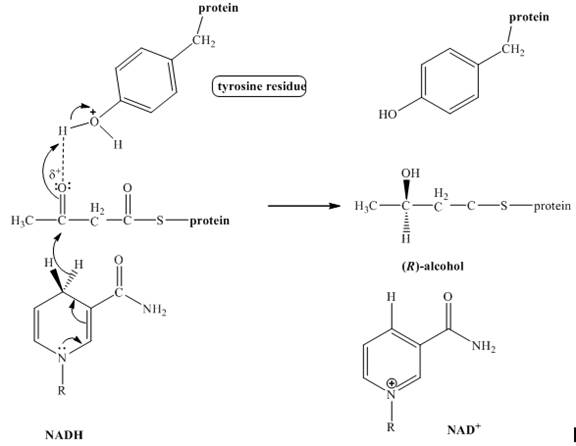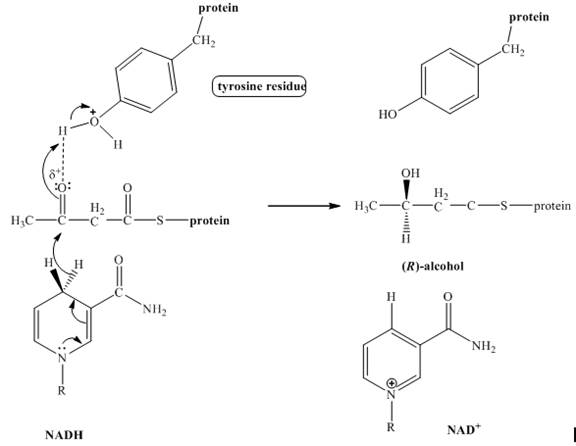
Concept explainers
(a)
Interpretation:
The product of the given reduction reaction including stereochemistry is to be shown.
Concept Introduction:
The compound
Answer:
The product of the given reduction reaction including stereochemistry is shown below.

Explanation:
The enzyme

Figure 1
Conclusion:
The product formed in the given reaction including stereochemistry is shown in Figure 1.
(b)
Interpretation:
The relative positions of
Concept Introduction:
The compound
(c)
Interpretation:
The role of the side chain hydroxyl group of tyrosine and serine in this reaction is to be stated.
Concept Introduction:
The compound
Want to see the full answer?
Check out a sample textbook solution
Chapter 19 Solutions
EBK ORGANIC CHEMISTRY
- Predict the major products (including stereochemistry) when cis-3-methylcyclohexanol reacts with the following reagents. (a) concentrated HBr (b) TsCl/pyridine, then NaBrarrow_forward(a) Draw the structures of the following compounds :(i) 4-Chloropentan-2-one (ii) p-Nitropropiophenone(b) Give tests to distinguish between the following pairs of compounds :(i) Ethanal and Propanal (ii) Phenol and Benzoic acid(iii) Benzaldehyde and Acetophenonearrow_forward10. Compound X (C4H9Br) reacts by heating with NaOH in H2O to form Y. The compound Y then undergoes acid catalysed hydration by H2SO, in 180°C to form 2-methyl prop-1-ene. (e) Determine the structure of X and Y. (f) Predict a MAJOR product when compound Y reacts with H2SO4 in 140 C. (g) Draw a structural isomer of X. Name the isomer using IUPAC nomenclature. (h) Describe a chemical test to distinguish between compound Y and 1-butanol.arrow_forward
- Give the products for each of the following reactions. (a) (b) (c) + H₂cod OCH3 о || -COCH 3arrow_forwardFollowing are the steps in the industrial synthesis of glycerin. Provide structures for all intermediate compounds (AD) and describe the type of mechanism by which each is formed.arrow_forwardCompound P, C4H9CI, reacts by heating with reagents KOH in ethanol to form Q (C4H8). The compound Q then undergoes acid catalysed hydration to form R (CAH100). R does not react with acidified warm sodium dichromate. (a) Determine the structure of P,Q and R (b) Give a reason why R does not react with acidified warm sodium dichromate. (c) Write chemical equation for the conversion of P to Q. (d) Draw a structural isomer of P.arrow_forward
- (a) Give the products of the phosphoric acid-catalyzed dehydration of 2-methylcyclohex-3- enol. Label the three products with major, minor, and trace amounts. OH H3PO4, heat (b) Describe the rule that is applied in the acid-catalyzed dehydration of 2-methylcyclohex-3- enol. Explain your answer based on the products formed.arrow_forwardPredict the products formed when limonene reacts with the followingreagents.(a) excess HBr (b) excess HBr, peroxides (c) excess Br2 in CCl4(d) ozone, followed by dimethyl sulfidearrow_forwardDeduce the structure of each compound from the information given. All unknowns in this problem have molecularformula C8H12.(a) Upon catalytic hydrogenation, unknown W gives cyclooctane. Ozonolysis of W, followed by reduction with dimethylsulfide, gives octanedioic acid, HOOC¬(CH2)6¬COOH. Draw the structure of W.(b) Upon catalytic hydrogenation, unknown X gives cyclooctane. Ozonolysis of X, followed by reduction with dimethylsulfide, gives two equivalents of butanedial, O“CH¬CH2CH2¬CH“O. Draw the structure of X.(c) Upon catalytic hydrogenation, unknown Y gives cyclooctane. Ozonolysis of Y, followed by reduction with dimethylsulfide, gives a three-carbon dialdehyde and a five-carbon dialdehyde. Draw the structure of Y.*(d) Upon catalytic hydrogenation, unknown Z gives cis-bicyclo[4.2.0]octane. Ozonolysis of Z, followed by reductionwith dimethyl sulfide, gives a cyclobutane with a three-carbon aldehyde (¬CH2¬CH2¬CHO) group on C1 and aone-carbon aldehyde (¬CHO) group on C2. Draw the…arrow_forward
- 6) Which is the organic product for the following reaction? (a) (b) (c) (d) LOH OH COOH OH OH COOH COOH KMnO4 H₂O (e) None of the above products will be formedarrow_forwardPredict the esterification products of the following acid/alcohol pairs.(a) CH3CH2CH2COOH + CH3OHarrow_forward(a) Explain how NaBH4 in CH3OH can reduce hemiacetal A to butane-1,4-diol (HOCH2CH2CH2CH2OH). (b) What product is formed when A is treated with Ph3P = CHCH2CH(CH3)2? (c) The drug isotretinoin is formed by reaction of X and Y. What is the structure of isotretinoin? Although isotretinoin (trade name Accutane or Roaccutane) is used for the treatment of severe acne, it is dispensed under strict controls because it also causes birth defects.arrow_forward
 Organic ChemistryChemistryISBN:9781305580350Author:William H. Brown, Brent L. Iverson, Eric Anslyn, Christopher S. FootePublisher:Cengage Learning
Organic ChemistryChemistryISBN:9781305580350Author:William H. Brown, Brent L. Iverson, Eric Anslyn, Christopher S. FootePublisher:Cengage Learning
